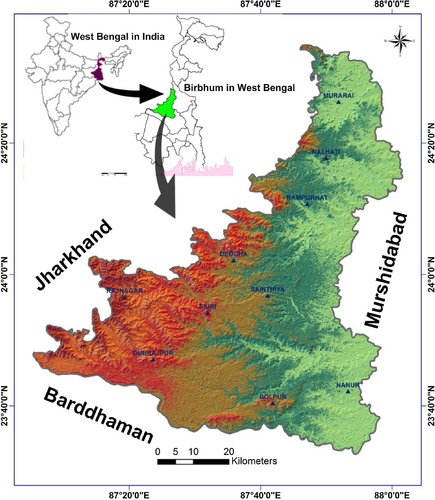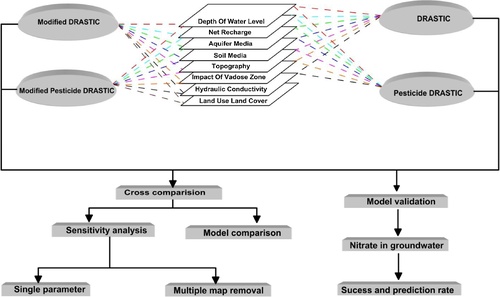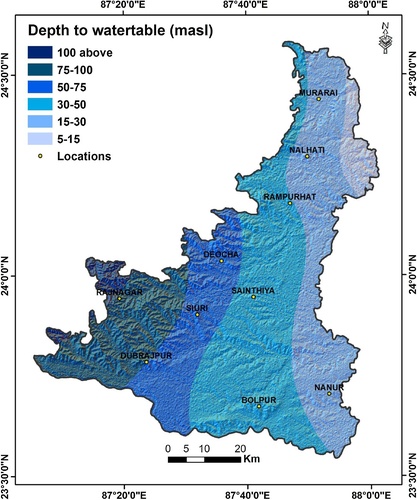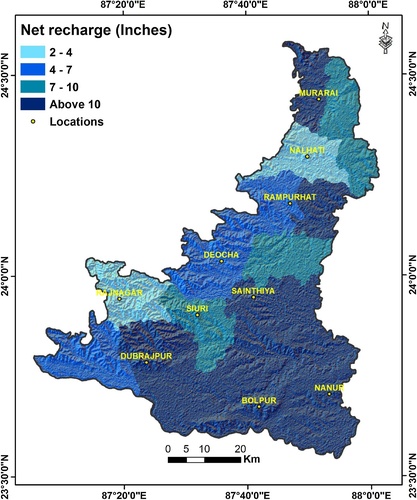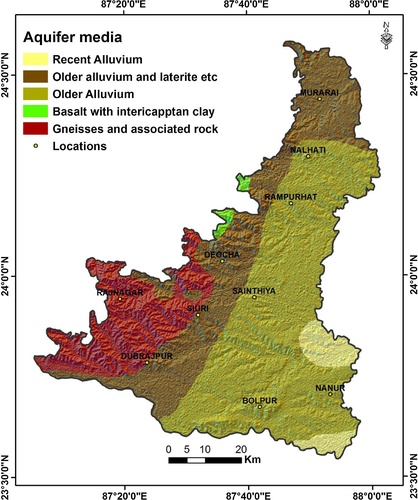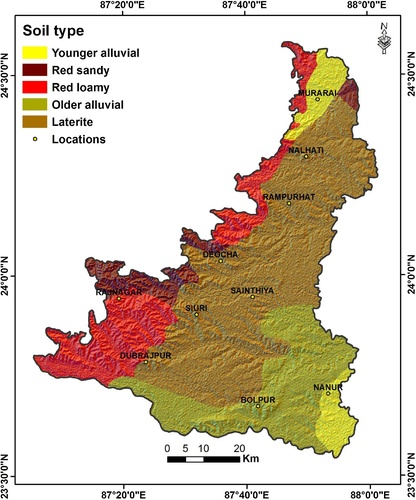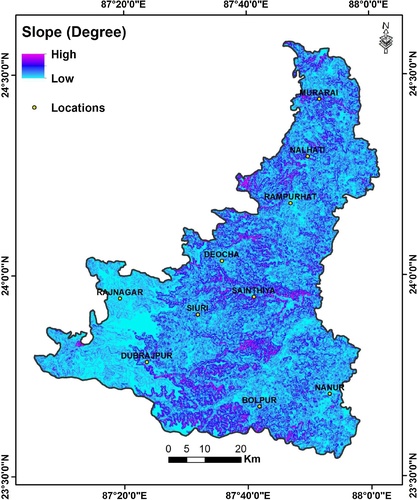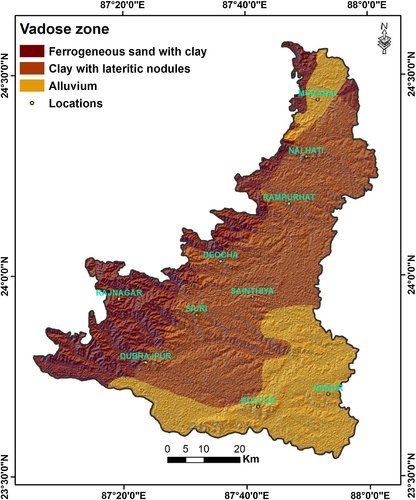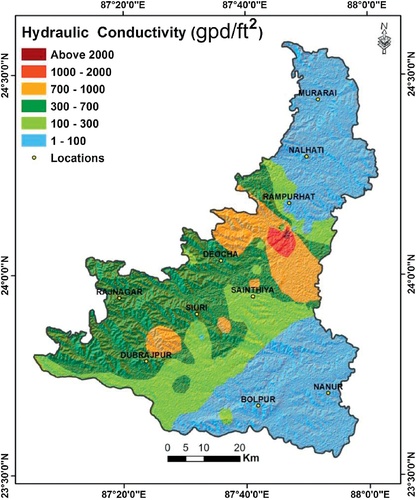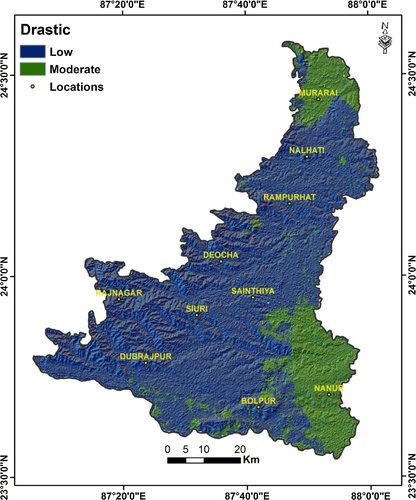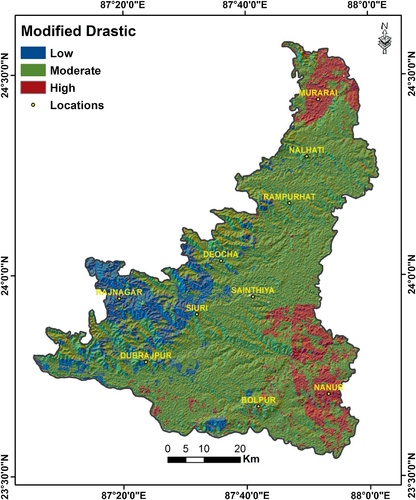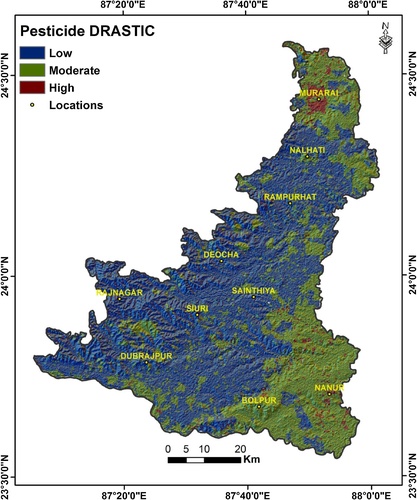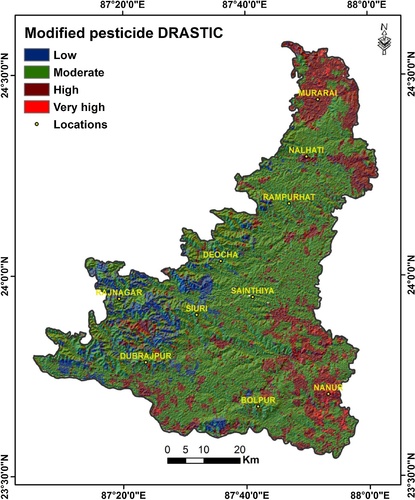 ?Mathematical formulae have been encoded as MathML and are displayed in this HTML version using MathJax in order to improve their display. Uncheck the box to turn MathJax off. This feature requires Javascript. Click on a formula to zoom.
?Mathematical formulae have been encoded as MathML and are displayed in this HTML version using MathJax in order to improve their display. Uncheck the box to turn MathJax off. This feature requires Javascript. Click on a formula to zoom.Abstract
The assessment of groundwater vulnerability is essential especially in developing areas, where agriculture is the main source of the population. In the present study, four different overlay and index method, namely, DRASTIC, modified DRASTIC, pesticide DRASTIC and modified pesticide DRASTIC are implemented with a view to identifying the most appropriate method that predicts the vulnerable zone to groundwater pollution. Sensitivity analysis reveals that net recharge is the most influential parameter of the vulnerability index. Cross comparison of model output shows the highest similarity of 97% is observed between drastic and modified drastic while the maximum difference in models prediction of 49% is observed between modified drastic and pesticide drastic. Reported nitrate concentrations in groundwater are considered for validation of model-generated final output map. The prediction power of the models are assessed using success and prediction rate method and it highlights DRASTIC model as the most suitable model with 89.69% and 84.54% of the area under area under the curve (AUC) for success and prediction rate respectively.
1 Introduction
Intense anthropogenic activities such as the application of chemicals in the agriculture field, industrialization and urbanization put immense pressures on groundwater resource causing degradation of groundwater quality (CitationOki and Kanae 2006; Kazakis and Voudouris, 2015). A groundwater vulnerability assessment deals with assessing the potential risk of groundwater to both natural and anthropogenic pollutants and their transportation in the aquifer from the surface (CitationYang et al., 2012). The vulnerability of groundwater is categorized into two types, namely, specific vulnerability and intrinsic vulnerability (CitationNational Research Council, 1993). Groundwater vulnerability to a group of contaminants or particular contaminants considering the properties and relationship of contaminants is termed as specific vulnerability (CitationGogu and Dassargues, 2000). When contaminants are introduced into the ground surface, the ease with which it can reach and diffuse in groundwater is termed as an intrinsic vulnerability. Anthropogenic activities nowadays manipulate the intrinsic vulnerability affecting factors such as soil media, net recharge, depth to groundwater etc. Hence making specific vulnerability more meaningful and important compared to intrinsic vulnerability (CitationHuan et al., 2012).
Various approaches such as such as statistical, process-based, overlay techniques and index methods are applied for mapping the vulnerability of groundwater (CitationBrindha and Elango, 2015). To perform statistical methods (such as principal component analysis, regression analysis, analytical hierarchical process, linear modeling, fuzzy logic models, krigging etc) and process-based approach requires huge reliable data and intensive fieldwork so that meaningful results can be obtained. Whereas, overlay techniques and index methods are simpler approaches to determine the vulnerability of a region based on geological, geomorphological, hydrogeological and other groundwater controlling factors. Various overlay and indexing method such as GOD (CitationFoster, 1987), AVI (CitationVan Stemproot et al. 1993), SEEPAGE (CitationNavulur, 1996), RISKE (CitationPetelet-Giraud et al. 2000), SI (CitationRibeiro, 2000), DRASTIC (CitationAller et al., 1987) Modified DRASTIC (CitationBrindha and Elango, 2015) etc. Selection of a particular method to assess the vulnerability of groundwater contamination is very tricky and complicated since the application of different methods may depict significantly different results. Hence, application of multiple models followed by their validation with actual groundwater scenario would be more appropriate rather than deciding the vulnerability of groundwater based on the outputs of the single model.
Mapping of Groundwater vulnerability acts as a basic tool for protection and management of groundwater resources (CitationMargane, 2003; CitationPatrikaki et al., 2012) and is implemented worldwide (CitationRahman, 2008; CitationWang et al., 2012). DRASTIC model was implemented for the first time by US Environmental Protection Agency (CitationAller et al., 1985, Citation1987), where the name stands for D = Depth to groundwater, R = Recharge rate, A = Aquifer media, S = Soil media, T = Topography, I = Impact of vadose zone, and C = hydraulic Conductivity of the aquifer. Researchers all around the globe have used DRASTIC model for aquifer vulnerability (CitationHuan et al., 2012; CitationNeshat et al., 2014). DRASTIC models and its modified versions typically involve linear combinations of various important factors (CitationKang et al., 2016). The accuracy of the DRASTIC model has been questioned by many authors and the model has been reported with mixed successes (CitationRupert 2001; Huan et al., 2012; CitationKang et al., 2016; CitationNeshat et al., 2014). Numerous studies have been carried out by different researchers with a modification in the DRASTIC models for making it more effective and accurate (CitationPathak and Hiratsuka, 2010; CitationWang et al., 2012). Nitrate as an indicator of groundwater pollution for assessment of vulnerability has been used suggested by many researchers (CitationAssafar and Saadeh, 2009; CitationHuan et al., 2012).
Birbhum being one of the important agricultural regions where approximately 81% of land cover is under cultivation sector, the agricultural field is often treated and burden with a huge amount of fertilizers and pesticides which can degrade the groundwater quality through contamination. Several studies on groundwater have been carried out earlier (CitationMondal et al., 2014; CitationThapa et al., 2017a,Citationb). Assessment of groundwater vulnerability to pollution has not been carried out in the study area. With this viewpoint, groundwater vulnerability assessment was carried out implementing four different overlay and index methods for vulnerability assessment, namely DRASTIC, modified DRASTIC, pesticide DRASTIC and modified pesticide DRASTIC followed by identifying the most reliable method among them. The model’s accuracy and feasibility are validated with reported nitrate concentration in groundwater as the sources of nitrate in groundwater are mostly anthropogenic rather than geogenic origin.
2 Study area
Birbhum district, also known as the ‘Land of Red Soil’, lies within 23° 32′ 30″ and 24° 35′ 0″ North latitude and 88° 1′ 40″ and 87° 5′ 25″ East longitude and encompasses an area of 4545 sq.km. Location map of the study area is represented in .
Archean rocks such as biotite-schist, calc-granulites, granites and granite-gneiss are exposed on the surface in the south-western and north-western part whereas basaltic Rajmahal traps are exposed in the northern part of Birbhum district. Tertiary formations show the presence of patchy occurrence. Yellowish-brown older alluvium occurs in the south-eastern and eastern regions. Recent floodplain deposits consisting mainly sand, silt and clay occur along stream course (CitationMondal et al., 2014; CitationThapa et al., 2017c).
Groundwater is the principal source of water for drinking and irrigation purpose in the district. The movement of groundwater is towards east from west. Tube wells in the eastern part of the district (average 100 m) are deeper and have higher yield in comparison to western regions of the district. Groundwater in Birbhum occurs in both confined and water-table condition where water table conditions are observed in alluvium, as well as hard weathered rocks and confined conditions, are observed in deeper alluvium. In the Tertiary formation beyond the depth of 136 mbgl (meters below ground level), auto-flow conditions of aquifer occur and the variation in piezometric head varies from 3 to 4 mbgl on an average.
3 Materials and method
The base map of Birbhum district was demarcated from Survey of India toposheet in 1:50,000 scale. Various input factors viz. depth to groundwater, recharge rate, aquifer media, soil media, topography, the impact of the vadose zone, and hydraulic conductivity of the aquifer were used to carry out the study. Geological Survey of India (GSI) resource map series was used to digitize geomorphology map of the study area. Depth to groundwater, aquifer media and hydraulic conductivity details was gathered from official website of Birbhum district and West Bengal PHED official website (CitationGovt. of West Bengal, 2017; CitationWBPhed, 2017) and net recharge map were generated from annual recharge data collected from Central Groundwater Board (CGWB). Impacts of the vadose zone, land use land cover, rainfall were georeferenced and digitized from district planning map series of NATMO, 2004. Soil texture map was collected from the official website of Birbhum District (http://birbhum.gov.in). These maps are generated with the help of ArcGIS10.1 software. The methodology adopted for the present study is represented schematically in .
3.1 Models for mapping vulnerability
Vulnerability assessment using the index and weighted overlay methods involves selection of factors affecting groundwater vulnerability, followed by their interpretation with assigning weights and rating, computation and demarcation of vulnerability classes. In the models applied, a score of 0–5 is assigned as weights where 0 indicate low pollution potential and 5 indicates relatively high pollution potential. The sub-classes of each input parameters are assigned a rating of 0–10, with 0 meaning low pollution potential and 10 meaning high pollution potential. The weights are multiplied by ranks for generating inputs maps which are overlaid over one another for generating final maps. The details of weights and rating assigned are represented in and .
Table 1 Different weights used for different parameters.
Table 2 Different rating of each parameter.
DRASTIC index as proposed by CitationAller et al. (1987) is expressed as follows (Eq. (Equation1(1)
(1) )):
(1)
(1)
where r represents rating, w represents weight, and D, R, A, S, T, I, C represent the input parameters as described above.
Pesticide DRASTIC index is also calculated using the (Eq. (Equation1(1)
(1) )) but the weights assigned to input parameters by CitationAller et al. (1987) are different to DRASTIC index i.e., the weights of D, R, and A input parameters are same whereas the weights of S, T, I and C parameters are different for both DRASIC and pesticide DRASTIC.
In the study area, anthropogenic activities involving the implementation of fertilizer and pesticide in agricultural field acts as prevalent contaminants to groundwater contamination. Hence, the ‘DRASTIC’ model was modified into ‘modified DRASTIC’ model with the incorporation of land use land cover as additional input parameters. Several researchers have implemented modified DRASTIC in their study (CitationBrindha and Elango, 2015). Modified DRASTIC is expressed by the equation below (Eq. (Equation2(2)
(2) )):
(2)
(2)
where r represents rating, w represents weight, LU is the Land use land cover and D, R, A, S, T, I, C represent the input parameters.
Eq. (Equation2(2)
(2) ) is also used for calculation of modified pesticide DRASTIC index with weights assigned by CitationBrindha and Elango (2015) The weights of D, R, A and LU input parameters are same whereas the weights of S, T, I and C parameters are different for both modified DRASIC and modified pesticide DRASTIC.
3.2 Sensitivity analysis
Sensitivity analysis (SA) measures the uncertainty or variation in the output results obtained from models applied (CitationSaltelli et al., 2008). In more general term it measures the robustness associated with the model output with manipulated input variables. It helps to understand the influence of individual input parameters on the model’s output by estimating the change in output map with each change in inputs. Researchers have studied the impact of input parameters on the model output which is influenced by several factors such as a number of input parameters, inaccuracy related to inputs, weights, and ranks assigned, nature of overlay performed (CitationHeuvelink et al., 1989). In the present study, two different methods of sensitivity were implemented i.e., single parameter sensitivity analysis (CitationNapolitano and Fabbri, 1996) and Map removal sensitivity analysis (CitationLodwick et al., 1990) to test the sensitivity of the various hydrogeological parameters. The statistical summary of rating of each parameter used in the study are obtained from in ArcGIS 10.1 software using symbology and classification statistics options of layer properties and the results are represented in .
Table 3 Statistical summary of rating.
3.2.1 Single parameter sensitivity analysis
Single parameter sensitivity analysis (CitationNapolitano and Fabbri, 1996) is used to assess the influence of individual input parameters on the vulnerability index. The mathematical expression is as follows (Eq. (Equation3(3)
(3) )):
(3)
(3)
where Sp is the sensitivity analysis, ‘Rp’ and ‘Rw’ are the rating and weights assigned to each parameter, and A is the overall vulnerability index of the model used (). Details of ‘Rp’ and ‘Rw’ assigned to each parameter are represented in and respectively.
Table 4 Single parameter sensitivity analysis.
3.2.2 Map removal sensitivity analysis
CitationLodwick et al. (1990) proposed the measurement of the sensitivity of input parameters with map removal sensitivity analysis where one or more inputs map are removed at a time from a suitability analysis. That method was preferred because it tests the sensitivity of operations between map layers. The equation is computed as follows (Eq. (Equation4(4)
(4) )):
(4)
(4)
‘SA’ represents the sensitivity index, ‘A’ and ‘B’ represents the vulnerability indices of unperturbed and perturbed outputs respectively and ‘X’ and ‘Y’ are the number of layers implemented for computing ‘A’ and ‘B’ respectively ().
Table 5 Multiple map removal sensitivity analysis.
The unperturbed vulnerability index is obtained by computing all the inputs parameters considered in the study whereas perturbed vulnerability index is the result of removing one or more parameters at a time.
3.2.3 Model comparison
For comparison of maps, the final output maps derived from the different model are reclassified and assigned numbers ranging from 1 to 4 where, 1 represents the low zone, 2 and 3 representing the moderate and high zone respectively and 4 being the very high zone. The reclassified maps of final output maps from the four models used are subtracted with one other and the results are represented in table format where zero values implies that there is no difference in prediction by two models, −1 and 1 indicates a difference of one vulnerability category between the two models, −2 and 2 represent difference of two venerability zones between the model and 3 and −3 implies the difference of three predicted zones.
4 Results and discussion
4.1 Input parameters
4.1.1 D — depth to groundwater
shows that approximately 97.35 sq.km (2%) of the study area bears groundwater above 100 mbgl (meter below ground level), 1191.73 sq.km (25%) area falls between 60 to 100 mbgl, 2976.25 sq.km (64%) have groundwater between 20 to 60 mbgl and 356.49 sq.km (7.7%) of the total area have groundwater with 20 mbgl. The groundwater tables give detail information about the depth and fluctuation of water over time. Groundwater depth is a crucial data for understanding groundwater, resource quantification, groundwater flow, and depends upon several other factors such as geological and hydrogeological condition, aquifer media, groundwater recharge scenario, precipitation, discharge rates etc. The high vulnerability is associated with low groundwater depth and vice versa.
4.1.2 R — net recharge
In the study area, approximately half of the area under investigation i.e., 2394.33 sq.km (51.8%) falls have net recharge potential of fewer than 4 in., 825.26 sq.km (17.86%) area has net recharge potential between 4 to 7 in., whereas 502.45 sq.km (10.87%) and 899.80 sq.km (19.47%) area has net recharge potential of 7–10 in. and above 10 in. respectively (). Net recharge refers to the amount of water entering an aquifer. The amount of recharge can be calculated on monthly or annual basis based on data available. Recharge is the main route for transportation of contaminants even though recharging of groundwater dilutes the concentration of contaminants entering into the aquifer. In our study area recharging occurs both naturally and through anthropogenic activities such as check dams, hydropower dam and man-made canal system routing the reclaimed or rainwater to the subsurface.
4.1.3 A — aquifer media
Older alluvium aquifers with moderate yield prospect cover approximately half of the study area i.e., 2235.55 sq.km (48%), older alluvium with laterite having limited yield prospect accounts for 29% of total study area i.e., an area of about 1341.66 sq.km, recent alluvium covers an area of 210 sq.km (4.54%), basalt with intericapptan clay accounts for 35.72 sq.km (0.77%) and granite and gneiss account for 17.28% of the study area which encompasses an area of 798.88 sq.km. (). Aquifer media is one of the most important factors influencing the chemical composition of groundwater. Transportation of underground pollutants is highly influenced by the aquifer media. Aquifer associated with higher permeability allows a high amount of water to pass through hence more contaminants reaches the underground water reservoirs.
4.1.4 S — soil media
Laterite soil type (Ultisols), younger alluvial (Entisols), older alluvial (Alfisols), red sandy (Alfisols), red loamy (Alfisols) covers approximately 2236.94 sq.km (48%), 318.17 sq.km (6.8%), 976.64 sq.km (20%), 260.99 sq.km (5.65%), and 829.08 sq.km (17.93) respectively (). Soil type of an area has a direct influence on the movement of water and contaminants to the aquifer through leaching from the soil surface. The amount of water percolation is significantly regulated by the soil type (CitationEl-Baz et al., 1995). Sorption phenomena and micro-organism in soils promote degradation of contamination to some extent.
4.1.5 T — topography
The entire study area is classified into three areas on the basis of slope angle i.e., slope <10° covering 3653.51 sq.km (79%), slope 10°–20° and slope 20°–80° covering 932.32 sq.km (20%) and 35.99 sq.km (01%) respectively in the study area (). From elevation point of view approximately 55% areas fall under 50 m elevation, 37% area lies within 50–100 m and 8% area falls above 100 m elevation. The gentle slope is associated with percolation of rainwater and surface runoff to the aquifer. Areas having gentle slope are plainer in topography with reduced drainage velocity. Slope determines whether the groundwater carrying contaminants will reach the groundwater reserve or will flow downhill as run-off. In areas with a steeper slope, the rainwater or surface runoff flows away very quickly giving less time for percolation (CitationMagesh et al., 2011; CitationWaikar and Nilawar, 2014).
4.1.6 I — impact of vadose zone
In the study area, ferruginous sand with clay, alluvium, and clay with lateritic nodules encompasses an area of 1090.07 sq.km (23.59%), 1294.82 sq.km (28.02%) and 2236.81 sq.km (48.40%) respectively (). Vadose zone is a complex medium for transport of groundwater where the flow rate can vary significantly. The discontinuously saturated or unsaturated soil horizon both above and below the water table is the vadose zone. Vadose zone facilitates the filtration out of harmful chemical through the soil matrix from recharging water entering into the aquifer.
4.1.7 C — hydraulic conductivity
In the study area, hydraulic conductivity is divided into six classes i.e., 1–100, 100–300, 300–700, 700–1000, 1000–2000, and above 2000 (gpd/ft2) encompassing an area of 1932.28 sq.km (41.80%), 842.07 sq.km (18.22%), 1370.43 sq.km (29.65%), 430.80 sq.km (9.32%), 42.76 sq.km (0.93%) and 4.07 sq.km (0.09%) respectively (). Hydraulic conductivity of an aquifer varies significantly due to the heterogeneity of geologic condition and its estimation helps in quantitative prediction of response of the aquifer to recharging and pumping activities.
4.1.8 LU — land use/land cover
A major portion of the study area is covered by cultivated area i.e., about 3763.97 sq.km (about 81%), forest area accounts for approximately 3.64% (168.39 sq.km) of the study area whereas rural settlements, urban settlements, industrial land, wasteland, water bodies occupying area of 466 sq.km (10%), 43 sq.km (1%), 46 sq.km (1%), 42 sq.km (1%), 113 sq.km (2%) respectively (). A various hydrological process such as evaporation, infiltration rates, surface runoffs etc is greatly influenced by the type of land cover (CitationWaikar and Nilawar, 2014). The introduction of fertilizers and pesticides in the agricultural field can trigger groundwater contamination.
4.2 Models output and cross comparison of models
Cross comparison of models assists to resolve the extent of similarity and dissimilarity of predictions of one model as compared to others models. It is better to implements several techniques for generating different outputs and perform a comparative study before selecting any one method as best and implementing it on a broader area to solve any problem under study. The statistical variation of each input parameter, represented in , indicates that net recharge contributes most significantly to aquifer vulnerability followed by aquifer media and land use land cover derived from equation (Eq. (Equation3(3)
(3) )) (CitationBrindha and Elango, 2015).
The vulnerability index in DRASTIC model ranges from 65 to 149 and the final output demarcates 3628.91 sq.km (79.88%) and 913.98 sq.km (20.12%) area under low and moderate groundwater vulnerability zones respectively (). In modified DRASTIC, the vulnerability index varies from 65 to 184 and the final output is divided into 3 vulnerability zones viz low, moderate and high encompassing an area of 537.99 sq.km (11.84%), 3486.08 sq.km (76.74%), 518.39 sq.km (11.81%) respectively (). In pesticide DRASTIC, vulnerability indices range from 60 to 187 and the final output of the model illustrates three vulnerability zones i.e., low accounting for 62.77% (2851.10 sq.km) of the total area, medium zone accounting for 35.29% (1602.73 sq.km) and high vulnerability zone covering an area of 1.95% (88.39 sq.km) (). The indices of vulnerability index ranges from 60 to 222 in modified pesticide DRASTIC () where, low, moderate, high and very high regions covers an area of 357.80 sq.km (7.88%), 3126.01 sq.km (68.85%), 1014.15 sq.km (22.34%) and 42.44 sq.km (0.93%) respectively. Modified pesticide DRASTIC is the only model showing zones having a very high vulnerability to groundwater pollution which attribute to use of land use land cover in this model.
4.3 Validation of model
To validate the accuracy of outputs of models, implemented for developing groundwater vulnerability zones, nitrate concentrations in groundwater has been widely used (CitationKhelif et al., 2016; CitationShrestha et al., 2016) as they are influenced by anthropogenic activities such as applications of fertilizers. For validations of model output, 109 reported nitrate concentration in groundwater (CitationCGWB, 2014; CitationMondal et al., 2014) within the Birbhum district has been implemented (Supplementary Table S1).
4.3.1 Success and prediction rate
The final output maps of the models are assessed to estimate the goodness of fit or how accurately the model predicted the occurrence of contamination in groundwater. To evaluate the predictive power of models is rather a difficult task as all approaches have their operational or conceptual pitfalls (CitationCarrara et al., 2008). Success and prediction rate curve are employed for validation of each models output. For generating success and prediction rate curve (CitationChung and Fabbri, 1999, Citation2003, Citation2008), the reported nitrate values in groundwater within the study area were grouped into two classes, namely train dataset and test dataset (CitationThapa et al., 2017a, Citationd). The susceptible index value obtained is categorized into 100 equal classes in descending order having a cumulative interval of 1% each.
The success rate curve (SRC) is generated by plotting the cumulative percentage of susceptible areas on the x-axis and cumulative percentage of nitrate occurrence in the training dataset on the y-axis (CitationChung and Fabbri, 2003; CitationSterlacchini et al., 2011). SRC constructed from the training dataset gives the prediction map but it does not convey the accuracy of prediction. Hence, to evaluate the future prediction accuracy of the model prediction rate curve (PRC) is implemented (CitationChung and Fabbri, 2003; CitationKaur et al., 2017, Citation2008; CitationThapa et al., 2017c). In PRC plotting the cumulative percentage of susceptible areas on the x-axis is compared against the cumulative percentage of nitrate occurrence in the test dataset on the y-axis. PRCs is also used for estimating the robustness of the prediction, effectiveness of models etc (CitationChung and Fabbri, 2003; CitationThapa et al., 2017a).
For the easy and comparative study of SRCs and PRCs generated from different models, Area under the curve (AUC) is referred which is represented as the percentage of graph falling under the curve (). Among all models applied, DRASTIC models, show the highest AUC for both SRCs and PRCs followed by modified DRASTIC and pesticide DRASTIC whereas least AUC for both SRCs and PRCs is seen in modified pesticide DRASTIC (a–d). The DRASTIC model depicts an accuracy of 89.69% and 84.54% for SRC and PRC respectively (a) and is the best fitting model for susceptible zonation of nitrate contamination in the study area.

Table 6 AUC of success and prediction rate curve for different models applied.
4.4 Sensitivity analysis
This sensitivity analysis helps to evaluate the desired vulnerability maps and also evaluate its consistency (CitationSaidi et al., 2011). Statistical calculation of results derived from removing only one layer at a time is represented in and the vulnerability index resulting by removing one or more layers at a time are represented in . In multiple map removal analysis, based on the results of , parameters causing least variation on final output were removed first followed by second least and so on. In the present study, vulnerability index is least sensitive to conductivity. In the context of anthropogenic sources of groundwater pollution, the influence of land use land cover is very low in our study area. This may be attributed to the absence of large-scale industries and factories in the study area.
4.5 Model comparison
The output obtained from the four model applied were compared to each other and the variation in the prediction of vulnerability zones through different models applied. represents all the possible combination of map comparison and indicates the variation of less than 50%. The highest similarity in prediction is observed between drastic and modified drastic with a similarity of 97% followed by 75% similarity between pesticide drastic and modified pesticide drastic. Highest discrepancies are observed between modified is observed between modified drastic and pesticide drastic with a difference of 48% in prediction, where approximately 43% corresponds to the difference in venerability prediction of 1 categories higher or lower. This variation is due to the implementation of one extra parameter i.e., land use land cover in pesticide drastic model (CitationBrindha and Elango, 2015).
Table 7 Difference in prediction in vulnerability classes between various models in percentage.
5 Conclusion
It is very crucial and needed to investigate the vulnerability of groundwater aquifer systems. Aquifer systems in our study area are under constant threats from potential pollution source both natural and anthropogenic. Despite threats, the quality of groundwater in the study area is generally good. Contamination of aquifer system does not occur very easily but once the groundwater is already contaminated, it becomes very difficult to combat or remediate aquifer contamination. Sensitivity analysis shows that net recharge is the most influential parameters for groundwater vulnerability followed by aquifer media and impact of the vadose zone. After comparing the outcome of all models applied with the actual groundwater status within the study area, DRASTIC models is observed to be the best model for prediction of groundwater vulnerability in Birbhum with a prediction accuracy of approximately 85%.
Supplementary Table S1
Download MS Word (25.8 KB)Acknowledgements
The author expresses his heartiest gratitude to the DST (project No. SB/ES-687/2013 dated 11.11.2014), Government of India for financial support to the project. The author would also like to thank Central Ground Water Board, Survey of India, and Geological Survey of India for their help and support.
Notes
Peer review under responsibility of National Water Research Center.
References
- L.AllerT.BennetJ.H.LehrR.J.PettyG.HacketDRASTIC: a Standardized System for Evaluating Groundwater Pollution Using Hydrological Settings1985Prepared by the National Water Well Association for the US EPA Office of Research and DevelopmentAda, OK, USA
- L.AllerT.BennetJ.H.LehrR.J.PettyG.HackettDRASTIC: a Standardized System for Evaluating Groundwater Pollution Potential Using Hydrogeological Settings. EPA/600/2-87/0351987US EPAAda, OK, USAhttps://nepis.epa.gov/Exe/ZyPDF.cgi/20007KU4.PDF?Dockey=20007KU4.PDF
- H.AssafarM.SaadehGeostatistical assessment of groundwater nitrate contamination with reflection on DRASTIC vulnerability assessment: the case of the Upper Litani BasinWater Resour. Manag.2342009775796https://link.springer.com/article/10.1007/s11269-008-9299-8
- K.BrindhaL.ElangoCross comparison of five popular groundwater pollution vulnerability index approachesJ. Hydrol.5242015597613 10.1016/j.jhydrol.2015.03.003
- A.CarraraG.CrostaP.FrattiniComparing models of debris flow susceptibility in the alpine environmentGeomorphology942008353378
- CGWB, 2014. Central Ground Water Board, Ministry of water resources government of India ground water year book of West Bengal & Andaman & Nicobar Islands (2013–2014) Technical Report: Series ‘D’ http://www.cgwb.gov.in/Regions/GW-year-Books/GWYB-2013-14/West%20Bengal%20GWYB%2013-14.pdf.
- C.-J.ChungA.G.FabbriProbabilistic prediction models for landslide hazard mappingPhotogramm. Eng. Remote Sens.65199913891399
- C.-J.ChungA.G.FabbriValidation of spatial prediction models for landslide hazard mappingNat. Hazards3032003451472 10.1023/B:NHAZ.0000007172.62651.2b
- C.-J.ChungA.G.FabbriPredicting landslides for risk analysis—spatial models tested by a cross-validation techniqueGeomorphology9432008438452 10.1016/j.geomorph.2006.12.036
- F.El-BazI.HimidaT.KuskyL.FieldingGroundwater Potential of the Sinai Peninsula, Egypt1995United States Agency for International DevelopmentCairo, Egypt
- Foster, S.S.D., 1987. Fundamental concepts in aquifer vulnerability, pollution risk and protection strategy. In: van Duijevenbooden, W., Van Waegeningh, H.G. (Eds.), Vulnerability of soil and groundwater to pollutants. Proceedings and information No. 838 of the International Conference held in the Netherlands, TNO Committee on Hydrogeological Research, Delft, The Netherlands, pp. 69–86.
- R.GoguA.DassarguesCurrent trends and future challenges in groundwater vulnerability assessment using overlay and index methodsEnviron. Geol.392000549559 10.1007/s002540050466
- Govt. of West BengalDistrict website of Birbhum2017 http://www.birbhum.gov.in/. (Accessed on January 2017)
- G.B.M.HeuvelinkP.A.BurroughA.SteinPropagation of errors in spatial modeling with GISInt. J. Geogr. Inf. Syst.341989303322 10.1080/02693798908941518
- H.HuanJ.WangY.TengAssessment and validation of groundwater vulnerability to nitrate based on a modified DRASTIC model: a case study in Jilin City of northeast ChinaSci. Total Environ.44020121423 10.1016/j.scitotenv.2012.08.037
- H.KaurS.GuptaS.ParkashR.ThapaApplication of geospatial technologies for multi-hazard mapping and characterization of associated risk at local scaleAnn. GIS2412008 10.1080/19475683.2018.1424739
- H.KaurS.GuptaS.ParkashR.ThapaR.MandalGeospatial modelling of flood susceptibility pattern in a subtropical area of West Bengal, IndiaEnviron. Earth Sci.762017339 10.1007/s12665-017-6667-9
- J.KangL.ZhaoR.LiH.MoY.LiGroundwater vulnerability assessment based on modified DRASTIC model: a case study in Changli County, ChinaGeocarto Int.3272016749758 10.1080/10106049.2016.1167969
- N.KazakisK.S.VoudourisGroundwater vulnerability and pollution risk assessment of porous aquifers to nitrate: modifying the drastic method using quantitative parametersJ. Hydrol.52520151325 10.1016/j.jhydrol.2015.03.035
- N.KhelifI.JmalS.BouriMapping global vulnerability index in mining sectors: a case study Moulares-Redayef aquifer system, southwestern TunisiaJ. Afr. Earth Sci.1212016108118 10.1016/j.jafrearsci.2016.05.028
- W.A.LodwickW.MonsonL.SvobodaAttribute error and sensitivity analysis of map operations in geographical information systems: suitability analysisInt. J. Geogr. Inf. Syst.41990413428 10.1080/02693799008941556
- A.MarganeGuideline for Groundwater Vulnerability Mapping and Risk Assessment for the Susceptibility of Groundwater Resources to Contamination2003BGRDamascus
- N.S.MageshN.ChandrasekarJ.P.SoundranayagamMorphometric evaluation of Papanasam and Manimuthar watersheds, parts of Western Ghats, Tirunelveli district, Tamil Nadu India: a GIS approachEnviron. Earth Sci.642011373381 10.1007/s12665-010-0860-4
- D.MondalS.GuptaD.V.ReddyP.NagabhushanamGeochemical controls on fluoride concentrations in groundwater from alluvial aquifers of the Birbhum district, West Bengal, IndiaJ. Geochem. Explor.1452014190206 10.1016/j.gexplo.2014.06.005
- Napolitano, P., Fabbri, A.G., 1996. Single-parameter sensitivity analysis for aquifer vulnerability assessment using DRASTIC and SINTACS. Application of Geographic Information Systems in Hydrology and Water Resources Management (Proceedings of the Vienna Conference, April 1996). IAHS Publ. no. 235 April 1996, 559–566.
- National Research Council (NRC)Groundwater Vulnerability Assessment, Contamination Potential under Conditions of Uncertainty1993National Academy PressWashington DC
- A.NeshatB.PradhanS.PirastehH.ZulhaidiM.ShafriEstimating groundwater vulnerability to pollution using a modified DRASTIC model in the Kerman agricultural area, IranEnviron. Earth Sci.717201431193131 10.1007/s12665-013-2690-7
- K.C.NavulurGroundwater Vulnerability Evaluation to Nitrate Pollution on a Regional Scale Using GIS (Unpublished Doctoral dissertation)1996Purdue UniversityIndiana
- T.OkiS.KanaeGlobal hydrological cycles and world water ResourcesScience313200610681072
- D.R.PathakA.HiratsukaAn integrated GIS based fuzzy pattern recognition model to compute groundwater vulnerability index for decision makingJ. Hydro-Environ. Res.5120106377 10.1016/j.jher.2009.10.015
- O.PatrikakiN.KazakisK.VoudourisVulnerability map: a useful tool for groundwater protection: an example from Mouriki Basin, North GreeceFresenius Environ. Bull.218c201225162521
- E.Petelet-GiraudN.DoerfligerP.CrochetRISKE: méthode d’evaluation multicritere de la cartographie de la vulnerabilite des aquifères karstiques. Application aux systèmes des Fontanilles et Cent-Fonts (Herault, Sud de la France). (RISKE: a multicriterion assessment method for mapping the vulnerability of karst aquifers. Application to Fontanilles and Cent-Fonts karst systems, Herault, southern France)Hydrogeologie420007188
- A.RahmanA GIS based DRASTIC model for assessing groundwater vulnerability in shallow aquifer in Aligarh, IndiaAppl. geogr.28120083253 10.1016/j.apgeog.2007.07.008
- M.G.RupertCalibration of the DRASTIC ground water vulnerability mapping methodGround Water3942001625630 10.1111/j.1745-6584.2001.tb02350.x
- Ribeiro, L., 2000. IS: um novo índice de susceptibilidade de 716 aquíferos a contaminaçao agricola [SI: a new index of aquifer susceptibility to agricultural pollution]. Internal report, ER-SHA/CVRM, Instituto Superior Tecnico, Lisbon, Portugal, 12 pp.
- S.SaidiS.BouriH.B.DhiaSensitivity analysis in groundwater vulnerability assessment based on GIS in the Mahdia-Ksour Essaf aquifer, Tunisia: a validation studyHydrol. Sci. J.5622011288304 10.1080/02626667.2011.552886
- A.SaltelliM.RattoT.AndresF.CampolongoJ.CariboniD.GatelliM.SaisanaS.TarantolaGlobal Sensitivity Analysis. The Primer2008John Wiley & Sons, Ltd. 10.1002/9780470725184.ch
- S.ShresthaR.KafleV.P.PandeyEvaluation of index-overlay methods for groundwater vulnerability and risk assessment in Kathmandu Valley, NepalSci. Total Environ.5752016779790 10.1016/j.scitotenv.2016.09.141
- S.SterlacchiniC.BallabioJ.BlahutM.MasettiA.SorichettaSpatial agreement of predicted patterns in landslide susceptibility mapsGeomorphology12520115161 10.1016/j.geomorph.2010.09.004
- R.ThapaS.GuptaD.V.ReddyApplication of geospatial modelling technique in delineation of fluoride contamination zones within Dwarka BasinGSF8201711051114 10.1016/j.gsf.2016.11.006
- R.ThapaS.GuptaA.GuptaD.V.ReddyH.KaurUse of geospatial technology for delineating groundwater potential zones with an emphasis on water-table analysis in Dwarka River basin, Birbhum, IndiaHydrogeol. J.2017124 10.1007/s10040-017-1683-0
- R.ThapaS.GuptaH.KaurDelineation of potential fluoride contamination zones in Birbhum, West Bengal, India, using remote sensing and GIS techniquesArab. J. Geosci.102017527 10.1007/s12517-017-3328-y
- R.ThapaS.GuptaD.V.ReddyS.GuinH.KaurAssessment of groundwater potential zones using multi-influencing factor (MIF) and GIS: a case study from Birbhum district, West BengalAppl. Water Sci.77201741174131 10.1007/s13201-017-0571-z
- D.Van StemprootL.EwertL.WassenaarAquifer vulnerability index: a GIS compatible method for groundwater vulnerability mappingCan. Water Resour. J.18119932537
- M.L.WaikarA.P.NilawarIdentification of groundwater potential zone using remote sensing and GIS techniqueIJIRSET3520141216312174
- J.WangJ.HeH.ChenAssessment of groundwater contamination risk using hazard quantification, a modified DRASTIC model and groundwater value Beijing Plain, ChinaSci. Total Environ.4322012216226 10.1016/j.scitotenv.2012.06.005
- WBPhedGround water prospects map - Birbhum district, West Bengal2017West Bengal Public Health Engineering Department, Govt. of West Bengal (Accessed on January 2017)http://www.wbphed.gov.in/
- G.F.YangY.H.JiangY.LiReview on urban groundwater vulnerability assessment by using DRASTIC modelGround Water34201258 (Chinese Journal)
Appendix A
Supplementary data
Supplementary data associated with this article can be found, in the online version, at https://doi.org/10.1016/j.wsj.2018.02.003.

